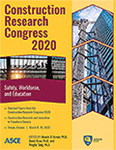Construction Research Congress 2020
Overcoming Physical Obstacles with Four-Wheeled Hand Carts: An Evidence-Based Ergonomics Guideline for the Commercial Roofing Trade
Publication: Construction Research Congress 2020: Safety, Workforce, and Education
ABSTRACT
Hand carts are used in nearly every construction trade for material handling. Nonetheless, the use of carts can be strenuous and lead to musculoskeletal injuries. This is particularly the case when carts are used in hazardous working conditions, such as physical obstacles and ramps. Unfortunately, little is known so far about the effects of these physical environmental hazards on cart operations. This study aims at understanding the operating forces required to overcome physical obstacles with a type of four-wheel carts commonly used in the commercial roofing trade. We varied obstacle heights, load weights, space constraints, and tire types in the laboratory experiment to reveal how hazardous an obstacle will be under different working circumstances commonly seen on construction sites. The space constraint is identified to be the most significant factor that determines the operating forces required to surmount an obstacle. This finding suggests the necessity of optimizing workplace layout to refrain workers from overcoming obstacles in a constrained space where the travel distance from cart to obstacle is less than 61 cm. An obstacle begins to yield noticeable impeding effect when it is higher than 3.8 cm, and any obstacle less than this threshold is not very hazardous especially when no space constraint is present. In addition, we found that pneumatic (air-filled rubber) tires are more favorable over solid (polyurethane foam-filled rubber) tires in overcoming obstacles and thus can be a convenient solution if it is infeasible to eliminate obstacles. The research findings can be used as reference information to develop numerical standards for manual cart handling, such as safe load restrictions and operating techniques, to increase ergonomics awareness and prevent musculoskeletal injuries in construction.
Get full access to this article
View all available purchase options and get full access to this chapter.
ACKNOWLEDGEMENTS
Funding and support for this project was provided by the State of Washington, Department of Labor and Industries, Safety and Health Investment Projects, (grant No. 2018ZH00361). The funding source had no role in the design and conduct of the study; collection, management, analysis, and interpretation of the data; or preparation, review, or approval of the manuscript.
REFERENCES
Al-Eisawi, Khaled W., Carter, J. Kerk, Jerome J. Congleton, Alfred A. Amendola, Omer C. Jenkins, and Will Gaines. 1999. “Factors Affecting Minimum Push and Pull Forces of Manual Carts.” Applied Ergonomics 30 (3): 235–245.
Andersen, Johan H., Jens P. Haahr, and Poul Frost 2007. “Risk Factors for More Severe Regional Musculoskeletal Symptoms: A Two-Year Prospective Study of a General Working Population.” Arthritis & Rheumatism 56 (4): 1355–1364.
Bennett, A. I., S. D. Desai, A. I. Todd, and H. Freeland 2008. “The Effects of Load and Gradient on Hand Force Responses during Dynamic Pushing and Pulling Tasks.” Ergonomics SA: Journal of the Ergonomics Society of South Africa 20 (1): 3–15.
Boyer, Jon, Jia-hua Lin, and Chien-chi Chang. 2013. “Description and Analysis of Hand Forces in Medicine Cart Pushing Tasks.” Applied Ergonomics 44 (1): 48–57.
British Health and Safety Executive. 2016. “Risk Assessment of Pushing and Pulling (RAPP) Tool.” 2016. http://www.hse.gov.uk/pubns/indg478.htm.
Dong, Xiuwen, Y. Men, and A. Fujimoto 2018. The Construction Chart Book.
Drury, Colin G. 1985. “Influence of Restricted Space on Manual Materials Handling.” Ergonomics 28 (1): 167–75. https://doi.org/10.1080/00140138508963125.
Haig, Andrew J. 2005. Back Pain: A Guide for the Primary Care Physician. ACP Press.
Jäger, M., A. Luttmann, and W. Laurig. 1984. “The Load on the Spine during the Transport of Dustbins.” Applied Ergonomics 15 (2): 91–98. https://doi.org/10.1016/0003-6870(84)90278-3.
Knapik, Gregory G., and William S. Marras. 2009. “Spine Loading at Different Lumbar Levels during Pushing and Pulling.” Ergonomics 52 (1): 60–70.
Kodak, Eastman. 1986. “Ergonomic Design for People at Work.” Volume 2: 20–30.
Lawson, Judith, Jules Potiki, and H. Watson. 1993. “Development of Ergonomic Guidelines for Manually Handled Trolleys in the Health Industry.” Journal of Occupational Health and Safety, Australia and New Zealand 9: 459–459.
Petzäll, Jan. 1996. “Traversing Step Obstacles with Manual Wheelchairs.” Applied Ergonomics 27 (5): 327–341.
Snook, Stover H., and Vincent M. Ciriello 1991. “The Design of Manual Handling Tasks: Revised Tables of Maximum Acceptable Weights and Forces.” Ergonomics 34 (9): 1197–1213. https://doi.org/10.1080/00140139108964855.
Information & Authors
Information
Published In
Construction Research Congress 2020: Safety, Workforce, and Education
Pages: 95 - 104
Editors: Mounir El Asmar, Ph.D., Arizona State University, David Grau, Ph.D., Arizona State University, and Pingbo Tang, Ph.D., Arizona State University
ISBN (Online): 978-0-7844-8287-2
Copyright
© 2020 American Society of Civil Engineers.
History
Published online: Nov 9, 2020
Published in print: Nov 9, 2020
Authors
Metrics & Citations
Metrics
Citations
Download citation
If you have the appropriate software installed, you can download article citation data to the citation manager of your choice. Simply select your manager software from the list below and click Download.
